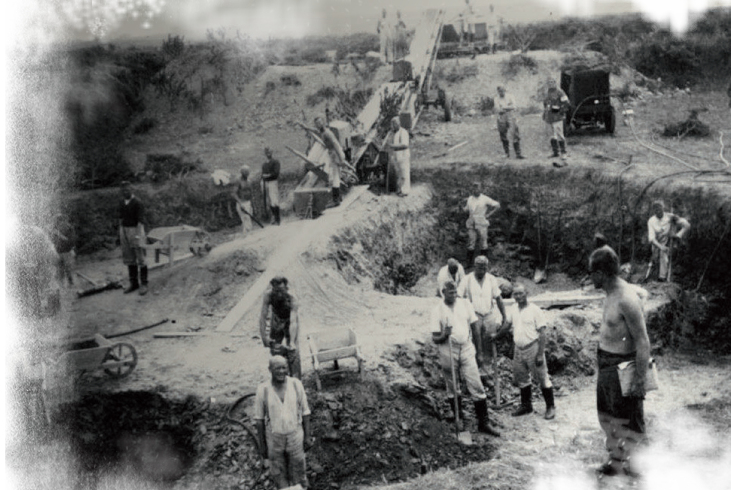Fortifications, a new era.
In October 1934 the German corps of fortress engineers (Festungspionierorganisation) was reorganized. A new standard construction rule (Regelbau) and a new building planning scheme (Regelbaupläne) were established, providing greater efficiency and streamlining production. These guidelines were applied until 1945.
With his war directive n° 40, dated 23 March 1942, Hitler gave a new impetus to linear fortifications. All the West facing coasts of all occupied territories had to be fortified urgently. The scope of the project was such that the Todt Organization and military engineers had to share the effort, particularly for smaller sites. Coasts had to be protected, all the way from the North of occupied Norway to the Spanish border. Some parts of the coastline did not lend themselves to a possible landing but others, such as the Breton coasts had to be fortified as a matter of priority.

Fortifications, a new era.
In October 1934 the German corps of fortress engineers (Festungspionierorganisation) was reorganized. A new standard construction rule (Regelbau) and a new building planning scheme (Regelbaupläne) were established, providing greater efficiency and streamlining production. These guidelines were applied until 1945.
With his war directive n° 40, dated 23 March 1942, Hitler gave a new impetus to linear fortifications. All the West facing coasts of all occupied territories had to be fortified urgently. The scope of the project was such that the Todt Organization and military engineers had to share the effort, particularly for smaller sites. Coasts had to be protected, all the way from the North of occupied Norway to the Spanish border. Some parts of the coastline did not lend themselves to a possible landing but others, such as the Breton coasts had to be fortified as a matter of priority.
A colossal construction effort and a methodical organization
The Atlantic Wall was built by the Germans from spring 1942 to spring 1944. It measured approximately 4000 km in length and numbered almost 15 000 concrete-reinforced sites. Such a project, executed over a short period of time was made possible by a methodical organization and a standardized building method. The plans of each type of bunker corresponded to a specific use and were compiled in a register of defensive positions… Each bunker type had its own set of plans: concrete formwork plans, steel reinforcement plans, plans for the ventilation and electrical systems etc. Quantities of sand, cement, gravel and steel were registered as well as the number of man-hours for each building operation. Similarly, each piece of equipment or accessory to be fitted inside was codified and standardized, from armoured door to ventilation outlet.

A colossal construction effort and a methodical organization
The Atlantic Wall was built by the Germans from spring 1942 to spring 1944. It measured approximately 4000 km in length and numbered almost 15 000 concrete-reinforced sites. Such a project, executed over a short period of time was made possible by a methodical organization and a standardized building method. The plans of each type of bunker corresponded to a specific use and were compiled in a register of defensive positions… Each bunker type had its own set of plans: concrete formwork plans, steel reinforcement plans, plans for the ventilation and electrical systems etc. Quantities of sand, cement, gravel and steel were registered as well as the number of man-hours for each building operation. Similarly, each piece of equipment or accessory to be fitted inside was codified and standardized, from armoured door to ventilation outlet.
The Todt Organization
The Todt Organization was responsible for the logistics and management of the construction sites. This was a German government agency that had before the war managed the construction of the German motorway network as well as that of the Siegfried line fortifications facing the Maginot line. In France, the O.T. was in charge of the management and coordination of the building sites. The main contractors were obviously German firms that sub-contracted with French builders and public works firms. The workforce consisted of volunteer workers and employees of firms that were either under contract or requisitioned; there was also requisitioned and forced labour of all nationalities. By the end of May 1944, around 291 000 men worked on the Atlantic Wall, whether they had chosen to or not.

The Todt Organization
The Todt Organization was responsible for the logistics and management of the construction sites. This was a German government agency that had before the war managed the construction of the German motorway network as well as that of the Siegfried line fortifications facing the Maginot line. In France, the O.T. was in charge of the management and coordination of the building sites. The main contractors were obviously German firms that sub-contracted with French builders and public works firms. The workforce consisted of volunteer workers and employees of firms that were either under contract or requisitioned; there was also requisitioned and forced labour of all nationalities. By the end of May 1944, around 291 000 men worked on the Atlantic Wall, whether they had chosen to or not.
